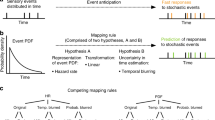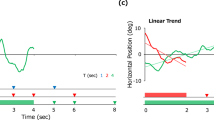Abstract
A perceived event such as a visual stimulus in the external world and a to-be-produced event such as an intentional action are subserved by event representations. Event representations do not only contain information about present states but also about past and future states. Here we focus on the role of representing future states in event perception and generation (i.e., prospective coding). Relevant theoretical issues and paradigms are discussed. We suggest that the predictive power of the motor system may be exploited for prospective coding not only in producing but also in perceiving events. Predicting is more advantageous than simply reacting. Perceptual prediction allows us to select appropriate responses ahead of the realization of an (anticipated) event and therefore, it is indispensable to flexibly and timely adapt to new situations and thus, successfully interact with our physical and social environment.
Similar content being viewed by others
References
Atance CM, O’Neill CM (2001) Episodic future thinking. Trends Cogn Sci 5:533–539
Bangert M, Altenmüller EO (2003) Mapping perception to action in piano practice: a longitudinal DC-EEG study. BMC Neurosci 4:26–36
Bekkering H, Wohlschläger A, Gattis M (2000) Imitation of gestures in children is goal-directed. Q J Exp Psychol A 53(1):153–164
Blakemore SJ, Frith C (2005) The role of motor contagion in the prediction of action Neuropsychologia 43:260–267
Bosbach S, Prinz W, Kerzel D (2004) A Simon-effect with stationary moving stimuli. J Exp Psychol: Hum Percept Perform 30(1):39–55
Bosbach S, Prinz W, Kerzel D (2005) Is direction position? Position- and direction-based compatibility effects in tasks with moving stimuli. Q J Exp Psychol 58A(3):467–506
Calvo-Merino B, Glaser DE, Grezes J, Passingham RE, Haggard P (2005) Action observation and acquired motor skills: an FMRI study with expert dancers. Cereb Cortex 15(8):1243–1249
Calvo-Merino B, Grezes J, Glaser DE, Passingham RE, Haggard P (2006) Seeing or doing? Influence of visual and motor familiarity in action observation. Curr Biol 16:1905–1910
Drost UC, Rieger M, Braß M, Gunter TC, Prinz W (2005) Action-effect coupling in pianists. Psychol Res 69(4):233–241
Eenshusitra RM, Weidema MA, Hommel B (2004) Deveolpment of the acquisition and control of action-effect associations. Acta Psychol 115:185–209
Elsner B, Hommel B (2001) Effect anticipation and action control. J Exp Psychol: Hum Percept Perform 27:229–240
Finke RA, Freyd JJ (1985) Transformations of visual memory induced by implied motions of pattern elements. J Exp Psychol: Learn, Mem, Cogn 11:780–794
Flanagan JR, Johansson RS (2003) Action plans used in action observation. Nature 424:769–771
Freyd JJ, Finke RA (1984) Representational momentum. J Exp Psychol: Learn, Mem, Cogn 10:126–132
Frith CD, Blakemore SJ, Wolpert DM (2000) Abnormalities in the awareness and control of action. Philos Trans R Soc B 355:1771–1788
Graf M, Reitzner B, Corves C, Casile A, Giese M, Prinz W (2007) Predicting point-light actions in real-time. Neuroimage (in press)
Greenwald AG (1970a) A choice reaction time test of ideomotor theory. J Exp Psychol 6(1):20–25
Greenwald AG (1970b) Sensory feedback mechanisms in performance control: with special reference to ideo-motor mechanism. Psychol Rev 77(2):73–99
Grush R (2004) The emulation theory of representation: motor control, imagery, and perception. Behav Brain Sci 27:377–442
Guttenplan S (1994) Natural kinds. In: Guttenplan S (ed) A companion to the philosophy of mind. Blackwell, Oxford, pp 449–450
Haueisen J, Knösche TR (2001) Involuntary motor activity in pianists evoked by music perception. J Cogn Neurosci 13:786–792
Heider F, Simmel M (1944) An experimental study of apparent behavior. Am J Psychol 57:243–259
Hoffmann J, Sebald A, Stoecker C (2001) Irrelevant response effects improve serial learning in a serial reaction time task. J Exp Psychol: Learn, Mem, Cogn 27:470–482
Hommel B (1993) Inverting the Simon effect by intention: determinants of direction and extent of effects of irrelevant spatial information. Psychol Res 55:270–279
Hommel B (1996) The cognitive representation of action: automatic integration of perceived action effects. Psychol Res 59:176–186
Hommel B, Müsseler J, Aschersleben G, Prinz W (2001) The theory of event coding (TEC): a framework for perception and action planning. Behav Brain Sci 24:849–937
Hubbard TL (1996) Representational momentum, centripetal force, and curvilinear impetus. J Exp Psychol: Learn, Mem, Cogn 22:1049–1060
Hubbard TL, Bharucha JJ (1988) Judged displacement in apparent vertical and horizontal motion. Percept Psychophys 44:211–221
James W (1890) The Principles of psychology. Holt, New York
Jeannerod M (2001) Neural simulation of action: a unifying mechanism for motor cognition. NeuroImage 14:S103–S109
Jellema T, Perrett DI (2003) Perceptual history influences neural responses to face and body postures. J Cogn Neurosci 15:961–971
Johansson G (1973) Visual perception of biological motion and a model for it’s analysis. Percept Psychophys 14:201–211
Keller PE, Koch I (2006) The planning and execution of short auditory sequences. Psychon Bull Rev 13:711–716
Kelso JAS (1994) Dynamic patterns: the self-organization of brain and behavior. MIT Press, Campridge, MA
Kerzel D (2002) A matter of design: No representational momentum without predictability. Vis Cogn 9:66–80
Kerzel D (2003) Attention maintains mental extrapolation of target position: Irrelevant distractors eliminate forward displacement after implied motion. Cognition 88:109–131
Kerzel D (2005) Representational Momentum beyond internalized physics: Embodied mechanisms of anticipation cause errors in visual short-term memory. Current Directions in Psychological Science 14(4):180–184
Kerzel D, Bekkering H, Wohlschläger A, Prinz W (2000) Launching the effect: Representations of causal movements are influenced by what they lead to. Q J Exp Psychol. A 53(4):1163–1185
Kerzel D, Gegenfurtner KR (2003) Neuronal processing delays are compensated in the sensorimotor branch of the visual system. Curr Biol 13(22):1975–1978
Kerzel D, Jordan JS, Mu¨sseler J (2001) The role of perception in the mislocalization of the final position of a moving target. J Exp Psychol: Hum Percept and Perform 27:829–840
Kilner JM, Vargas C, Duval S, Blakemore SJ, Sirigu A (2004) Motor activation prior to observation of a predicted movement. Nat Neurosci 7:1299–1301
Koch I, Kunde W (2002) Verbal response-effect compatibility. Mem Cognit 30:1297–1303
Kozak M, Marsh AA, Wegner DM (2006) What do I think you’re doing? Action identification and mind attribution. J Pers Soc Psychol 90:543–555
Krekelberg B, Lappe M (2001) Neuronal latencies and the position of moving objects. Trends Neurosci 24:335–339
Kunde W (2001) Response-effect compatibility in manual choice-reaction tasks. J Exp Psychol: Hum Percept Perform 27(2):387–394
Kunde W (2004) Response priming by supraliminal and subliminal action effects. Psychol Res 68:91–96
Kunde W, Weigelt M (2005) Goal congruency in bimanual object manipulation. J Exp Psychol: Hum Percept Perform 31:145–156
Mechsner F, Kerzel D, Knoblich G, Prinz W (2001) Perceptual basis of bimanual coordination. Nature 414:69–72
Mechsner F, Prinz W (2003) What is coordinated in bimanual coordination? In: Tschacher W, Dauwalder JP (eds) The dynamical systems approach to cognition. Studies of nonlinear phenomena in life science, Vol. 10. World Scientific, Singapore
Michaels CF (1988) S–R compatibility between response position and destination of apparant motion: Evidence for the detection of affordances. J Exp Psychol: Hum Percept Perform 14:231–240
Michotte A (1963) The perception of causality. London: Methuen. (Original work published 1946)
Nattkemper D, Prinz W (2001) Impact of task demands on spatial stimulus–response compatibility. Z Psychol 209:205–226
Nijhawan R (1994) Motion extrapolation in catching. Nature 370:256–257
Nijhawan R (2002) Neural delays, visual motion and the flash-lag effect. Trends Cogn Sci 6:387–393
Prinz W (1990) A common coding approach to perception and action. In: Neumann O, Prinz W (eds) Relationships between perception and action: current approaches. Springer-Verlag, Berlin, pp 167–201
Prinz W (1997) Perception and action planning. Eur J Cogn Psychol 9:129–154
Prinz W (2006) What re-enactment earns us. Cortex 42:515–517
Proctor RW, Van Zandt T, Lu CH, Weeks DJ (1993) Stimulus–response compatibility for moving stimuli: Perception of affordances or directional coding? J Expl Psychol: Hum Percept Perform 19(1):81–91
Reed CL, Vinson NG (1996) Conceptual effects on representational momentum. J Exp Psychol: Hum Percept Perform 22:839–850
Rizzolatti G, Craighero L (2004) The mirror-neuron system. Ann Rev Neurosci 27:169–192
Schubotz RI, von Cramon DY (2002) Predicting perceptual events activates corresponding motor schemes in lateral premotor cortex: an fMRI study. NeuroImage 15:787–796
Schubotz RI, von Cramon DY (2004) Sequences of abstract non-biological stimuli share ventral premotor cortex with action observation and imagery. J Neurosci 24:5467–5474
Semjen A, Summers JJ, Cattaert D (1995) The coordination of the hands in bimanual circle drawing. J Exp Psychol: Hum Percept Perform 21:1139–1157
Simon JR (1969) Reactions toward the source of stimulation. J Exp Psychol 81:174–176
Simon JR, Rudell AP (1967) Auditory S–R compatibility: The effect of an irrelevant cue on information processing. J Appl Psychol 51:300–304
Stoecker C, Hoffmann J (2003) The ideomotor principle and motor sequence acquisition: tone effects facilitate movement chunking. Psychol Res 68:126–137
Stoecker C, Sebald A, Hoffmann J (2003) The influence of response-effect compatibility in a serial reaction time task. Q J Exp Psychol 56A:685–703
Szpunar KK, Watson JM, McDermott KB (2007) Neural substrates of envisioning the future. Proceedings of the National Academy of Sciences USA 104(2):642–647
Vallacher RR, Wegner DM (1985) A theory of action identification. Lawrence Erlbaum Associates, Hillsdale, NJ
Vallacher RR, Wegner DM (1987) What do people think they’re doing? Action identification and human behavior. Psychol Rev 94:3–15
Verfaillie K, d’Ydewalle G (1991) Representational momentum and event course anticipation in the perception of implied periodical motions. J Exp Psychol: Learn, Mem, and Cogn 17:302–313
Weigelt M, Rieger M, Mechsner F, Prinz W (2007) Target-related coupling in bimanual reaching movements. Psychological Research (in press)
Wilson M (2001) Perceiving imitatible stimuli: consequences of isomorphism between input and output. Psychol Bull 127:543–553
Wilson M (2005) Covert imitation: how the body schema acts as a prediction device. In: Knoblich G, Thornton I, Grosjean M, Shiffrar M (eds) Perception of the Human body from the inside out. Oxford University Press, Oxford
Wilson M, Knoblich G (2005) The case for motor involvement in perceiving conspecifics. Psychol Bull 131:460–473
Wolpert DM, Doya K, Kawato M (2003) A unifying computational framework for motor control and social interaction. Phil Trans R Soc Lond B 358:593–602
Wolpert DM, Flanagan JR (2001) Motor prediction. Curr Biol 11:R729–R732
Wolpert DM, Miall RC, Kawato M (1998) Internal models in the cerebellum. Trends in Cognitive Sciences 2:338–347
Ziessler M, Nattkemper D (2001) Learning of event sequences is based on response-effect learning: further evidence from a serial reaction task. J Exp Psychol: Learn, Mem Cogn 27:595–613
Author information
Authors and Affiliations
Corresponding author
Rights and permissions
About this article
Cite this article
Schütz-Bosbach, S., Prinz, W. Prospective coding in event representation. Cogn Process 8, 93–102 (2007). https://doi.org/10.1007/s10339-007-0167-x
Received:
Revised:
Accepted:
Published:
Issue Date:
DOI: https://doi.org/10.1007/s10339-007-0167-x




